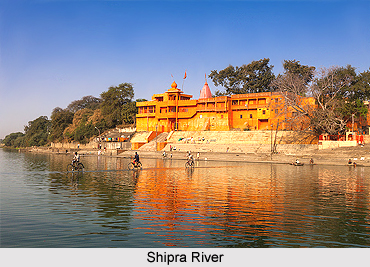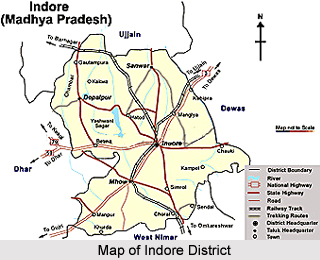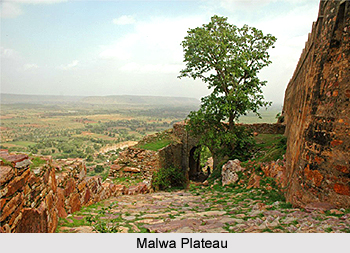 Indore district is one of the well-known districts in the state of Madhya Pradesh in India. This district is located on the Malwa plateau at an altitude of 553 meters above sea level, on the banks of two small rivulets; the Sarasvati River and the Khan River. They unite at the centre of the city where a small 18th Century temple of Sangamnath or Indreshwar exists. The name "Indore" is due to this deity. Indore is the headquarters of this district in the Madhya Pradesh state in central India. The Indore district is having 4 blocks which are Sanwer, Indore, Depalpur and Mhow. The 5 tehsils of this district are Indore, Sanwer, Mhow, Depalpur and Hatod. The district of Indore has 335 panchayats, 677 revenue villages in 5 tehsils, 649 development villages in 4 blocks and 36 police stations.
Indore district is one of the well-known districts in the state of Madhya Pradesh in India. This district is located on the Malwa plateau at an altitude of 553 meters above sea level, on the banks of two small rivulets; the Sarasvati River and the Khan River. They unite at the centre of the city where a small 18th Century temple of Sangamnath or Indreshwar exists. The name "Indore" is due to this deity. Indore is the headquarters of this district in the Madhya Pradesh state in central India. The Indore district is having 4 blocks which are Sanwer, Indore, Depalpur and Mhow. The 5 tehsils of this district are Indore, Sanwer, Mhow, Depalpur and Hatod. The district of Indore has 335 panchayats, 677 revenue villages in 5 tehsils, 649 development villages in 4 blocks and 36 police stations.
History of Indore District
Situated on one of the oldest pilgrimage routes of India from Mahakaal at Ujjain on Shipra River, to Omkareshwar on the Narmada River and onwards to Rameshwaram, the district of Indore was a convenient resting place. It was on the route of the Marathas of Deccan on their way to North India. These Maratha guerrilla warriors were in constant battle with the rulers of the Mughal Dynasty. Their army transit camps at this place attracted the local Zamindars or property owners who, drawn by the promise of lucrative trade, settled in the villages on the confluence of the Khan River and Saraswati River, thereby laying the foundation of this commerce centres in 1715.
In the year 1741, temple of Indreshwar was erected in the town, from which it derives the name Indore. The trade centre grew rapidly under the rule of Holkar dynasty (1733-1818). The remains of their two-century-old palace still stand in the main square (called Rajwada). The city became the capital of the Indore princely state in 1818 after the British forces under Sir John Malcolm defeated the Holkars led by Rani Krishnabai Holkar at Mahidpur. She signed the treaty of Mandsaur by which the control of Indore went in the hand of the British East India Company. Between 1948 and 1956, Indore served as the summer capital of the former Madhya Bharat state.
Geography of Indore District
The total geographical area of the district of Indore is spread over 3,898 square kilometres. Due to its location in Central India, far from the sea, Indore district experiences an extreme climate. In winter, which is from November to February, the night low temperature is around 10 degrees Celsius. At the peak of winter, it can be as low as low as 2 degrees to 3 degrees Celsius. The record low is 1.5 degrees Celsius. During summer, which is from April to June, the days are hot at about 35 to 40 degrees Celsius with the peak summer day temperature sometimes touching 45 degrees Celsius, which falls in the month of May. However, unlike other places in central India, the summer nights in Indore district are something special. Due to its location on the southern edge of the Malwa Plateau, however hot it may be during the day, in the late evening, cool breeze starts, which makes the evenings quite pleasant, referred to as Shab-e-Malwa. The district of Indore gets moderate rainfall of 30 to 35 inches during July-September due to the South-West Monsoon.
Demography of Indore District
According to the Population Census in 2011, Indore District had population of 3,272,335. Out of which the male and female were 1,700,483 and 1,571,852 respectively. Indore District population constituted 4.51 percent of total population of Madhya Pradesh. The population density of Indore district is 839 people per sq. km. Indore district administers 3,898 square kilometres of areas. The average literacy rate of Indore District was 82.32 percent. According to the gender, the male and female literacy rates were 89.22 and 74.89 percent respectively. The total literates in Indore District were 2,358,338. Out of which the males and females were 1,324,967 and 1,033,371 respectively.
 Culture of Indore District
Culture of Indore District
Over the years the district of Indore has welcomed people from all castes, creed, colour; People from all parts of the country particularly Kerala who have migrated and settled in the heart of Madhya Pradesh for their education, livelihood, or just for its peaceful culture. People of this district are highly social and progressive. That is why all cultures from north, south, east and west have mingled in the life of Indorians. Indore reflects the true spirit of unity in diversity. The mixed culture can be constantly seen in the typical food habits ranging from South Indian `Vada-Sambhar`, `Idli-Dosa` to `Dal-Bafla` typical Malwa food. The district of Indore is known for its wide variety of `Namkeens`, Gujarati and Chinese food restaurants, Bengali sweets, etc. All national festivals including Holi, Rakhi, Rang Panchmi, Nagpanchami, Ahilya Utsav, Lord Ganesha Utsav, Annat Chaudas, Garba Dance of Gujrat (Navratri Utsav), Dussehra, New Year`s Eve, Diwali, etc are celebrated with equal ease and comfort.
Tourism of Indore District
The district of Indore is famous form its major attractions which draw a large number of tourists from different corners of the state as well as from various other parts of the country throughout the year. The Indore museum is one of the most prominent attractions of this district, which houses the finest collection of Parmaras sculptures from Hinglajgarh. The Parmara style originated here and is characterized by proportionate figures, carefully and ornately depicted in stone. The museum is well known for its collection of coins, arms and armours.
Mahatma Gandhi Hall is another major attraction in Indore district. This is one of the attractive buildings in Indore. Constructed in the year 1904, and originally named as King Edward Hall, was renamed as Mahatma Gandhi Hall in the year 1948. This Indo-Gothic structure is made in Seoni stone and its domes and steeples are a landmark of Indore city. It has a clock tower in front, and thus it is known locally as Ghanta Ghar. The central hall has a capacity for 2000 people and is frequently the venue of book or painting sales, exhibitions and fairs all around the year.
 Nehru Park is the oldest and most centrally located park in Indore. Built by the Britons as Biscow Park, it was open only to British in the pre-independence days. It was renamed as Nehru Park after independence. It exhibits a variety of roses, library, swimming pool, children`s hobby centre etc. Another well-known park in this district is the Kamala Nehru Park (Zoo). More popularly known as Chidiya Ghar, it combines the pleasure of a park and zoo on a modest, easy reachable area. Some of the most prominent places of pilgrimage in the district of Indore are Kaanch Mandir, Bada Ganapati, Geeta Bhavan, temple of Annapurna, Gopal Mandir, Indore, etc.
Nehru Park is the oldest and most centrally located park in Indore. Built by the Britons as Biscow Park, it was open only to British in the pre-independence days. It was renamed as Nehru Park after independence. It exhibits a variety of roses, library, swimming pool, children`s hobby centre etc. Another well-known park in this district is the Kamala Nehru Park (Zoo). More popularly known as Chidiya Ghar, it combines the pleasure of a park and zoo on a modest, easy reachable area. Some of the most prominent places of pilgrimage in the district of Indore are Kaanch Mandir, Bada Ganapati, Geeta Bhavan, temple of Annapurna, Gopal Mandir, Indore, etc.






